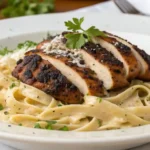Salmon in cast iron skillet. The screaming‑hot pan leaves the skin shatter‑crisp, while a quick finish in the oven keeps the center moist and flaky. Better yet, everything happens in one pan, so cleanup is easy.
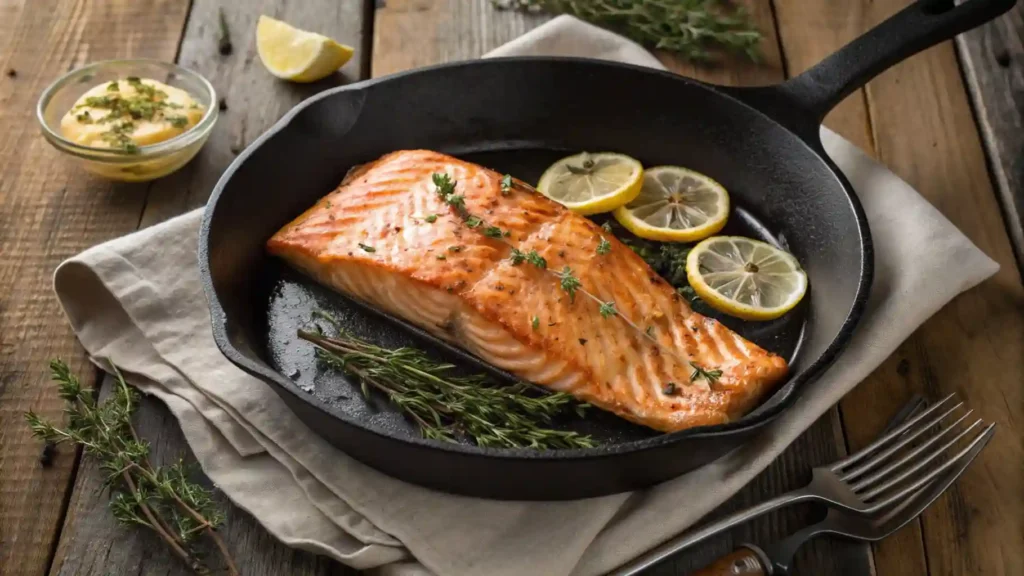
In this recipe you’ll learn how to:
- Choose quality fillets—whether wild‑caught sockeye or responsibly farmed Atlantic
- Pat, season, and sear the fish for restaurant‑worthy crust
- Baste with butter, garlic, and lemon to layer on big flavor
- Serve the finished salmon alongside simple sides that make the whole meal shine
If you’ve struggled with soggy skin or dry, overcooked fish, the clear steps ahead will fix that for good. Heat up your cast iron—this is how you cook salmon to perfection with bold flavor and crispy skin.
Table of Contents
Why You’ll Love This Recipe
Crispy skin, every time: A pre‑heated cast‑iron skillet sears the skin until it crackles—no soggy bites.
Big flavor with few ingredients: Salt, pepper, smoked paprika, butter, garlic, and lemon deliver a restaurant‑level finish without fuss.
Fast weeknight timing: From fridge to plate in about 15 minutes; perfect when you need dinner now.
One‑pan convenience: Sear on the stove, finish in the oven, baste, and serve—all from the same skillet.
Works with any salmon: Wild sockeye, king, or quality farmed fillets all turn out tender and juicy with this method.
Naturally nutritious: High‑quality protein plus omega‑3 fats—no heavy breading or complicated sauces required.
Whether you’re a cast‑iron pro or new to pan‑seared seafood, this straightforward technique guarantees salmon in cast iron that’s crisp, tender, and loaded with flavor—every single time.
Ingredients
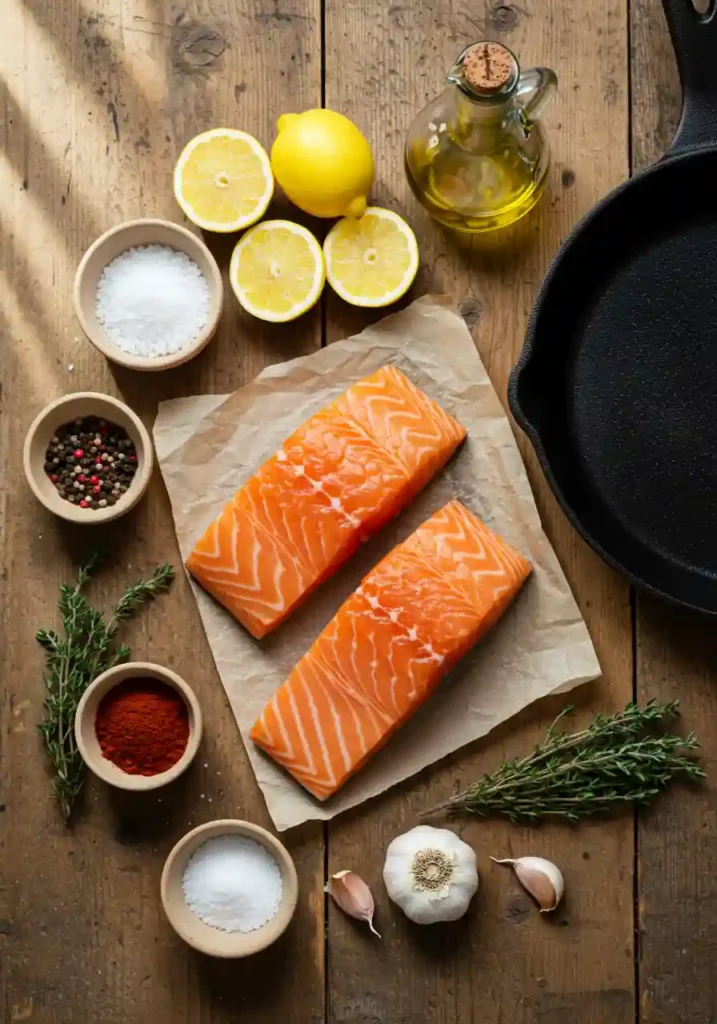
Salmon
- 2 skin‑on salmon fillets (6–8 oz each, about 1 inch thick)
- 1 tablespoon olive or avocado oil
- 1 teaspoon kosher salt
- ½ teaspoon freshly ground black pepper
- ½ teaspoon smoked paprika (adds color and mild heat)
Flavor Finish
- 1 tablespoon unsalted butter
- 1 garlic clove, lightly smashed
- 2 thin lemon slices
- Fresh parsley, chopped (garnish)
Ingredient Note
- Wild‑caught salmon (sockeye or king) offers firmer texture and deeper flavor, but high‑quality farm‑raised fillets work too.
- If using frozen salmon, thaw completely and pat very dry before seasoning to ensure a crispy sear.
Instructions
Follow these steps and you’ll get crispy‑skin, juicy salmon in cast iron every time.
Step 1. Pre‑heat the Skillet
- Set your cast-iron skillet over medium-high heat to get it hot and ready for searing.
- Let it warm for 4 minutes—the pan should be hot before the fish touches it.
Step 2. Prep and Season the Fillets
- Pat the salmon fillets dry with paper towels. Dry skin = crispy skin.
- Brush or rub both sides with the olive oil.
- Sprinkle the flesh and skin side evenly with salt, pepper, and smoked paprika.
- Press the seasoning in so it adheres.
Step 3. Sear the Salmon—Skin Side Down
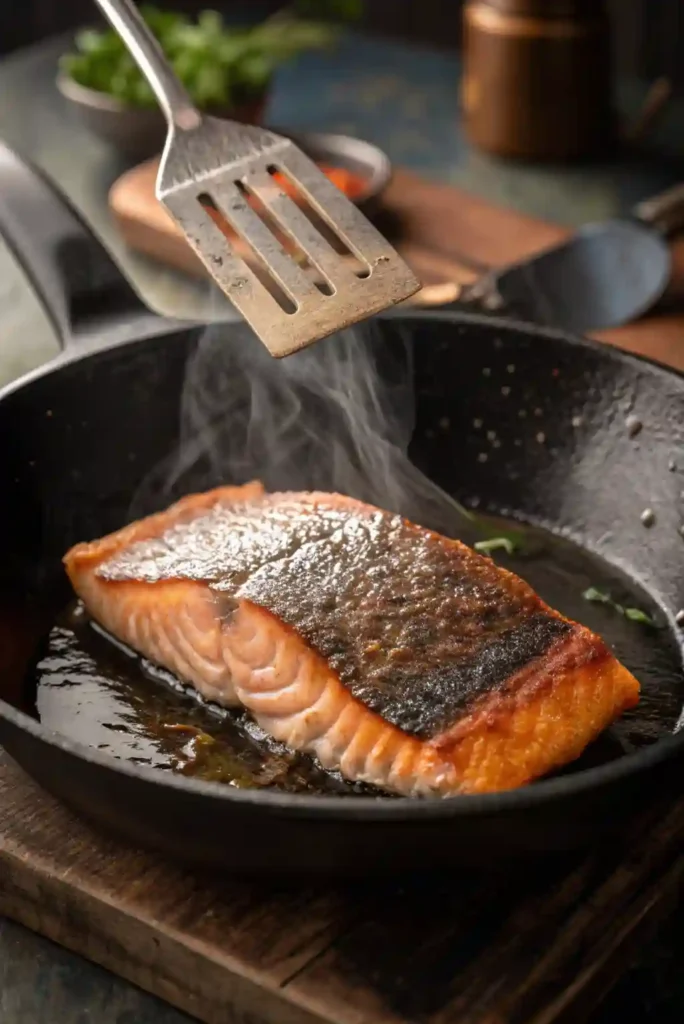
- Add 1 teaspoon oil to the hot cast iron and swirl to coat.
- Carefully lay each fillet skin side down. It should sizzle right away.
- Do not move the salmon for 3–4 minutes. A crust will form and release naturally when ready.
- While it sears, tilt the pan slightly and spoon hot oil over the exposed flesh for extra flavor.
Step 4. Flip and Finish in the Oven
- Flip the salmon with a thin metal spatula—lift gently to keep the skin intact.
- Slide the skillet into a 400 °F pre‑heated oven.
- Roast 3–5 minutes, depending on thickness, until the center is opaque and flakes easily (internal temp 125–130 °F for medium).
Step 5. Butter Baste for Extra Flavor

- Once done, return the pan to medium heat to continue cooking or finish your sauce.
- Add the butter, smashed garlic, and lemon slices.
- When the butter foams, tilt the pan and spoon the melted butter over the salmon for 30 seconds.
Step 6. Rest and Serve
- Carefully remove the salmon and let it sit on a plate for a couple of minutes to rest. This keeps it moist.
- Spoon a little pan butter over the top.
- Garnish with fresh parsley and serve immediately.
You now have perfectly crisp, flaky cast‑iron salmon—ready for your favorite sides.
Pro Tips and Variations
Pro Tips for Fool‑Proof Results
- Pre‑heat the skillet thoroughly. A blazing-hot skillet is essential for giving the salmon skin a crisp finish in no time.
- Pat the salmon completely dry. Moisture leads to steaming; dry fillets sear and brown beautifully.
- Choose a high‑smoke‑point oil. Olive, avocado, or grapeseed oil won’t burn at cast‑iron temperatures.
- Give each fillet space. If the pan is crowded, the skin turns rubbery instead of crispy. Cook in two batches if necessary.
- Watch the internal temperature. Pull the salmon off the heat at around 125°F for a medium finish—carryover heat will do the rest.
- Rest before serving. Two minutes off the heat allows juices to redistribute, keeping the fish flaky and tender.
Flavor Variations
- Lemon‑Herb: Replace the smoked paprika with lemon zest and dried thyme, then finish with an extra squeeze of fresh lemon.
- Maple‑Soy Glaze: Add a tablespoon of maple syrup and a teaspoon of soy sauce to the butter while basting for sweet‑savory depth.
- Garlic‑Parmesan Crust: After searing, sprinkle grated parmesan on the flesh side; it melts into a nutty golden crust in the oven.
- Nashville‑Hot: Mix cayenne and a pinch of brown sugar into the seasoning, then stir a dash of hot sauce into the finishing butter.
- Mediterranean Style: Season with oregano and cumin, then top the cooked salmon with chopped tomatoes, olives, and feta.
Alternate Cooking Methods
- All‑Stovetop: Sear skin side down, lower the heat, flip, and cook another three to four minutes until the center flakes.
- Skinless Fillets: Sear the flesh side first for color, flip once, then finish in the oven as directed.
- Oven‑Only: Preheat the cast‑iron skillet in a 425 °F oven, add oiled and seasoned fillets skin side up, and roast for ten to twelve minutes—less cleanup, slightly softer skin.
Use these pointers and tweaks to keep your cast‑iron salmon exciting, flavorful, and perfectly cooked every time.
Serving Suggestions
Pairing a richly seared salmon in cast iron with the right sides and extras turns a quick skillet supper into a well‑rounded meal. Here are several easy ideas:
Garlic‑roasted asparagus or broccolini
Toss the spears with olive oil, salt, pepper, and a little minced garlic. Roast at the same 400 °F you use to finish the salmon so everything comes out together.
Lemon couscous
Fluffy couscous cooked in light chicken broth and finished with a splash of lemon juice absorbs the buttery pan juices from the fish.
Simple arugula salad
Peppery arugula, shaved parmesan, and a drizzle of balsamic vinaigrette cut through the salmon’s richness and add a refreshing bite.
Herbed baby potatoes
Pan‑roast halved baby potatoes with rosemary and sea salt. Their crispy edges echo the salmon skin’s crunch.
Cauliflower rice pilaf
For a lower‑carb option, sauté cauliflower rice with onion, parsley, and a handful of toasted almonds to provide texture without heaviness.
Sauce add‑ons
- A spoonful of Greek yogurt mixed with chopped dill and a squeeze of lemon offers a cool contrast.
- For heat lovers, whisk hot sauce into the leftover pan butter and drizzle lightly over the plated fillets.
With any of these sides, your cast‑iron salmon becomes a complete, satisfying dinner you can pull off on even the busiest evening.
Conclusion
Cooking salmon in a blazing‑hot cast‑iron skillet is one of the simplest ways to elevate dinner. The technique guarantees crispy skin, moist flesh, and deep, caramelized flavor—all in under twenty minutes and with minimal cleanup. By drying the fillets well, seasoning boldly, and finishing briefly in the oven, you can transform basic ingredients into a dish that feels both effortless and gourmet.
Whether you keep the flavors classic with butter, garlic, and lemon or experiment with maple‑soy glazes and Mediterranean toppings, this cast‑iron method adapts easily to your tastes. Pair the finished salmon with quick roasted vegetables, a bright salad, or lemon‑kissed couscous, and you have a balanced meal that’s weeknight‑fast yet dinner‑party worthy.
Give this recipe a try, trust the heat of your cast‑iron pan, and enjoy salmon that’s crisp, tender, and packed with big flavor every time you cook it.
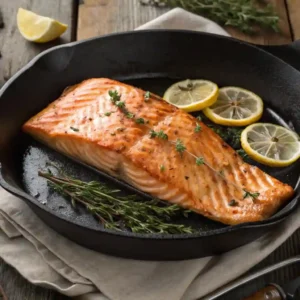
Salmon in Cast Iron
Ingredients
Salmon
- 2 skin‑on salmon fillets 6–8 oz each, about 1 inch thick
- 1 tablespoon olive or avocado oil
- 1 teaspoon kosher salt
- ½ teaspoon freshly ground black pepper
- ½ teaspoon smoked paprika adds color and mild heat
Flavor Finish
- 1 tablespoon unsalted butter
- 1 garlic clove lightly smashed
- 2 thin lemon slices
- Fresh parsley chopped (garnish)
Ingredient Note
- Wild‑caught salmon sockeye or king offers firmer texture and deeper flavor, but high‑quality farm‑raised fillets work too.
- If using frozen salmon thaw completely and pat very dry before seasoning to ensure a crispy sear.
Instructions
Step 1. Pre‑heat the Skillet
- Place a cast‑iron skillet on the stove over medium‑high heat.
- Let it warm for 4 minutes—the pan should be hot before the fish touches it.
Step 2. Prep and Season the Fillets
- Pat the salmon fillets dry with paper towels. Dry skin = crispy skin.
- Brush or rub both sides with the olive oil.
- Sprinkle the flesh and skin side evenly with salt, pepper, and smoked paprika.
- Press the seasoning in so it adheres.
Step 3. Sear the Salmon—Skin Side Down
- Add 1 teaspoon oil to the hot cast iron and swirl to coat.
- Carefully lay each fillet skin side down. It should sizzle right away.
- Do not move the salmon for 3–4 minutes. A crust will form and release naturally when ready.
- While it sears, tilt the pan slightly and spoon hot oil over the exposed flesh for extra flavor.
Step 4. Flip and Finish in the Oven
- Flip the salmon with a thin metal spatula—lift gently to keep the skin intact.
- Slide the skillet into a 400 °F pre‑heated oven.
- Roast 3–5 minutes, depending on thickness, until the center is opaque and flakes easily (internal temp 125–130 °F for medium).
Step 5. Butter Baste for Extra Flavor
- Return the skillet to the stove on medium heat.
- Add the butter, smashed garlic, and lemon slices.
- When the butter foams, tilt the pan and spoon the melted butter over the salmon for 30 seconds.
Step 6. Rest and Serve
- Transfer the salmon to a plate and let it rest 2 minutes. This keeps it moist.
- Spoon a little pan butter over the top.
- Garnish with fresh parsley and serve immediately.
Notes
- Calories: 400 kcal
- Total Fat: 24g
- Saturated Fat: 6g
- Cholesterol: 95mg
- Sodium: 220mg
- Carbohydrates: 1g
- Fiber: 0g
- Sugars: 0g
- Protein: 42g
FAQs
What shouldn’t be cooked in cast iron?
Very acidic foods that simmer for long periods—like tomato sauce or wine‑based stews—can strip the skillet’s seasoning. Quick acidic sautés are fine; extended braises are better in stainless steel.
What oil is best for cast iron salmon?
Choose a high‑smoke‑point oil such as avocado, refined olive, or grapeseed. These stand up to the skillet’s high heat without burning, ensuring a clean sear and pleasant flavor.
How to cook fish in cast iron without sticking?
Start by thoroughly drying the salmon, lightly oiling the flesh, and searing it skin-side down in a fully preheated pan. Don’t disturb the salmon too early—once the crust forms, it’ll naturally lift from the pan when it’s time to flip.
Will fish ruin cast iron?
No. Properly seasoned cast iron handles fish well. Just avoid leaving cooked fish in the pan for hours, and give the skillet a quick rinse, light scrub, and oil wipe after cooking.
What is the tastiest way to cook salmon?
Many cooks favor the high‑heat sear‑and‑finish method: sear salmon skin side down in a hot cast‑iron skillet, flip, then finish briefly in the oven. This yields crispy skin and juicy flesh with minimal effort.
Is salmon better in the oven or frying pan?
A hybrid approach—pan sear for crisp skin, then finish in a hot oven—offers the best of both worlds: intense surface heat for texture and gentle, even cooking for perfectly flaky salmon.

